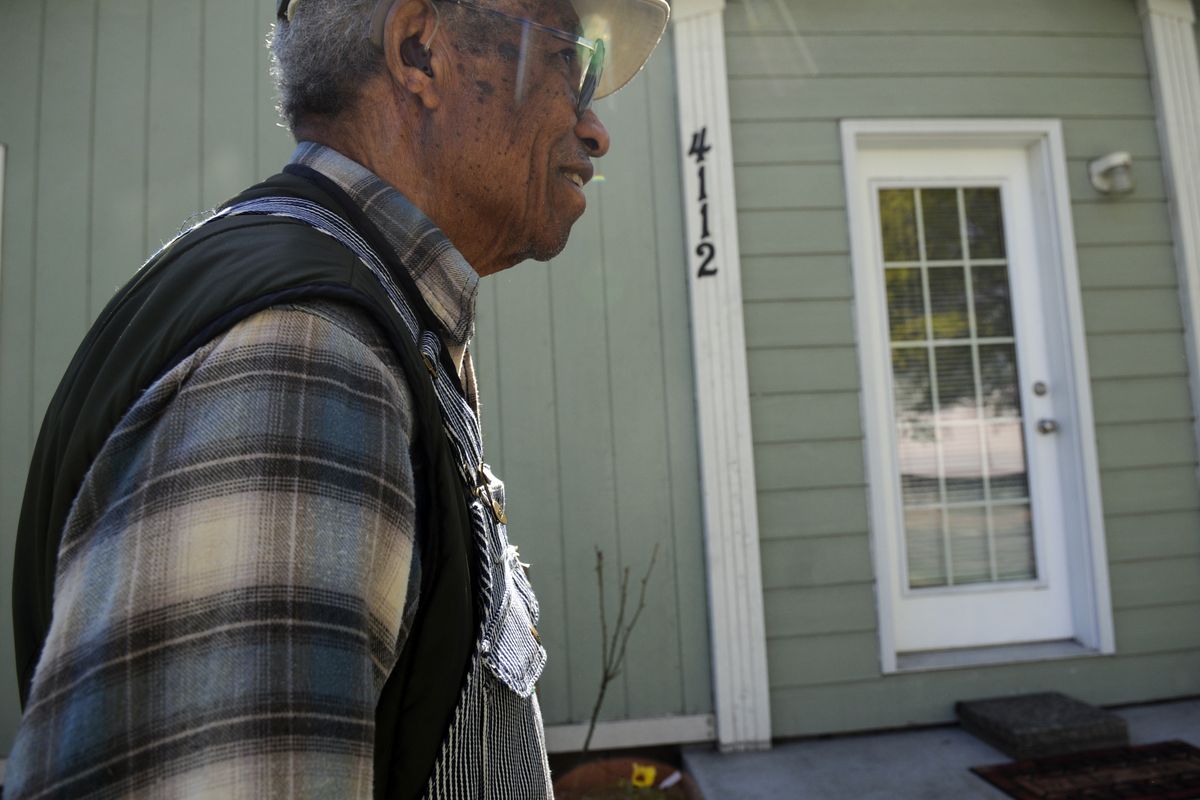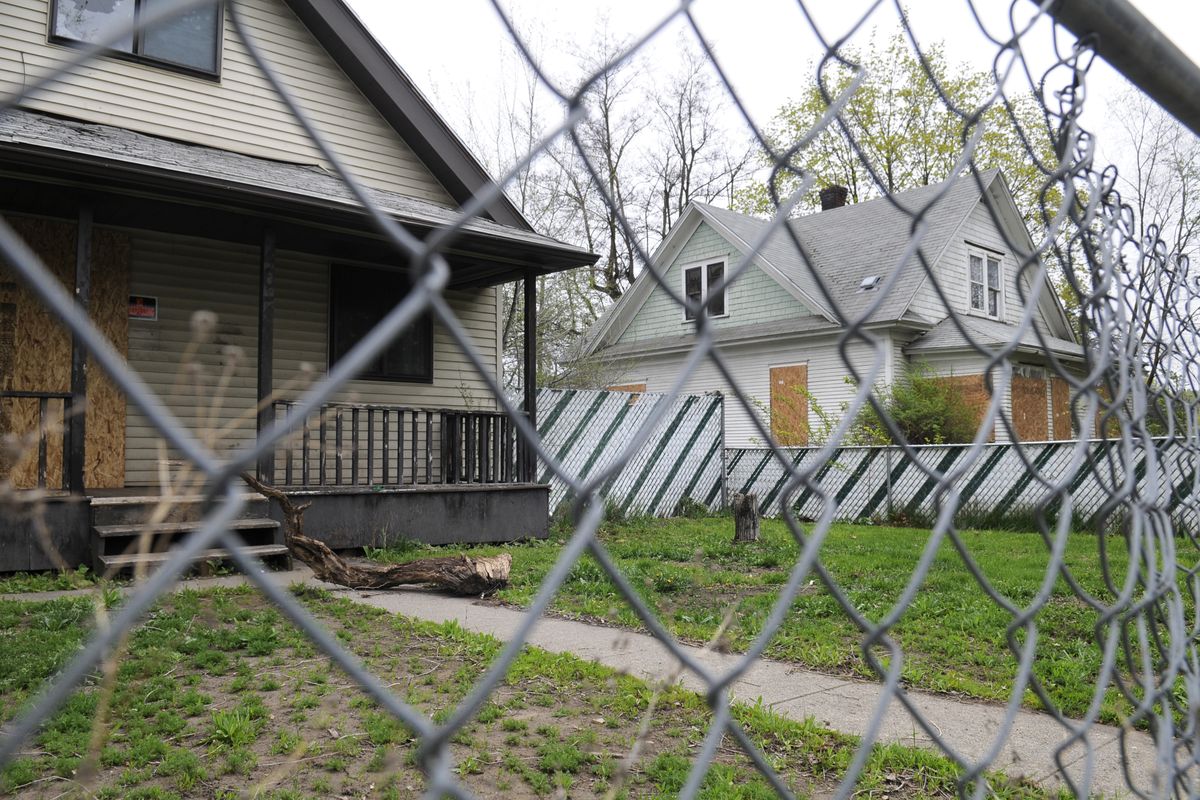Freeway redraws housing footprint
East Central losing hundreds of homes to accommodate project
Tommy Fletcher stands in front of his East Central home on Friday. He recently moved into this house several blocks from where he lived for decades. He’s one of many residents along I-90 whose home will be bulldozed to make way for the north-south freeway interchange. (Jesse Tinsley)
With decades of studies, draft reports, public meetings and money shortfalls, Spokane’s north-south freeway has remained more of a concept than a road.
Even the portion of the freeway that opened last year north of city limits is used by only about 4,000 vehicles a day – about a third of the traffic on the busiest portion of Garland Avenue.
But to hundreds of residents in the East Central neighborhood, the North Spokane Corridor is reality.
Over the past two years, the state Department of Transportation has moved aggressively to buy and tear down houses it says will be in the way of freeway expansion. While many East Central residents say the state has treated them fairly, the possible tripling of lanes on Interstate 90 leading to the corridor and the loss of homes in the neighborhood worry low-income housing advocates as well as some of those left behind.
So far, the state has purchased about 200 homes in East Central. Of those, about 135 have been removed. Most were torn down, but about a dozen were sold and moved to vacant land outside the freeway’s path. The state plans to hire contractors in the coming months to tear down 50 more. In the next two years, officials plan to buy about 200 more residences south of I-90.
Shirley Woods-Jensen, who lives one lot from the area that the state earmarked for purchase, bought her home in 1971 and raised six kids there. The houses behind hers are gone.
“I see a lot of my life is just disappearing,” said Woods-Jensen, a home health care worker. “It’s going to be like none of us were ever here.”
The acquisitions don’t come as a surprise. The freeway has been discussed for 60 years, and the route was finalized by the Federal Highway Administration in 1997.
Still, the loss of more than 400 homes will put a crunch on affordable housing in the community even if the state succeeds in finding new residences for individuals displaced by the freeway, said Chris Venne, development finance manager at Community Frameworks, a nonprofit organization that develops low-income housing.
“We’re having a hard time keeping up with the need for affordable housing without losing units,” Venne said. “It would take significant production of new housing units to make up the shortfall.”
In 2007 and 2008 several low-income downtown apartments closed. But government and nonprofit agencies rallied, and last year a record number of low-income apartments were built, said Cindy Algeo, executive director of the Spokane Low Income Housing Consortium.
Venne said the phased-in nature of the highway project hasn’t sparked the same sense of urgency.
“This is happening a bit more in slow motion, but it’s bigger,” Venne said. “I’m not sure people in the community are talking about it like it should be.”
State ‘listened to the neighborhood’
Many of the homeowners in the area said they were ready to leave and were offered good deals to do so.
Tommy Fletcher, who lived at 220 S. Rebecca St. for 40 years, this month moved a few blocks away. He said he was treated well by the state and compensated fairly.
“I have no qualms,” Fletcher said. “I’m happy to see progress.”
Several years ago neighborhood leaders requested that, if the route was unavoidable, the state move quickly so homeowners wouldn’t be left in limbo and vacant houses wouldn’t be left for squatters and blight.
“At least the DOT has listened to the neighborhood and done what we asked them to do,” said Jerry Numbers, a former chairman of the East Central Neighborhood Council.
State officials hope removal of homes is a sign to doubters that the freeway is finally more than talk.
“They can see progress,” said Roxanne Grimm, acquisition supervisor for the Department of Transportation’s eastern region. “They know it’s not a matter of if there’s going to be a north Spokane freeway, but when it’s going to be done.”
The northern half of the freeway from near Francis Avenue to U.S. Highway 395 is expected to be complete by the end of 2011. But the $1.6 billion needed to construct the freeway from Francis Avenue to I-90 is not in hand. Construction will happen, officials say, when federal, state and local leaders decide how to pay for it.
Further division in East Central
East Central, a working-class area east of downtown, suffered more than any other neighborhood in the city from the construction of I-90 in the 1950s. Hundreds of homes were torn down, and businesses along East Sprague were devastated by rerouted traffic.
As a result of the highway, there were fewer customers in the neighborhood and driving by on East Sprague, said Jim Hanley, who owns Acme TV, a business started by his father in 1945.
“The very first thing is a lot of people were just gone,” said Hanley, who grew up in East Central. “The people who remained were cut off from their friends.”
When it was built, I-90 essentially split East Central in two; the neighborhood again will be significantly affected by a new freeway. But despite the loss of more homes, Hanley said he believes the new road will help more than hurt by attracting jobs and pulling freight off city streets.
The state has $150 million set aside to secure freeway right-of-way south of Francis, mostly for residences and mostly for East Central. The state has spent $34 million of that so far.
In most of East Central, I-90 will expand from six to 14 or more lanes to help make the connection to the northern route. To accomplish that, the state will build over Second Avenue north of the freeway and Third Avenue on the south, and will take half and full blocks of homes on each side of the highway. Also in the way are more than eight full blocks just west of the Thor-Freya couplet where massive ramps to the corridor – called “the trumpet” – will start heading north.
Venne, who has lived in East Central since 1978, said the trumpet’s most recent design is “way overbuilt.”
“It’s already a huge concrete river dividing the neighborhood,” Venne said. “Here we’ve got kind of a throwback design back to the old thinking. It’s too expensive, too big and probably more than what we ought to be doing.”
Making room for the trumpet
Project engineers say the extra lanes are planned to allow traffic on two major highways to merge safely. State Sen. Chris Marr, D-Spokane, said the state should be open to ideas to lessen the freeway’s impact on East Central – but not at the expense of efficiently moving freight and traffic.
“I’m not afraid of that discussion,” Marr said. “If we can get it done on a Chevy budget, we’ll do it.”
If the trumpet ultimately is scaled back, Marr said he won’t have regrets that the state bought more land than it needed. Homeowners shouldn’t be kept waiting, and buying the land now will save money in the long run, he said.
“We know the biggest problem we run into is escalating real estate and relocation costs,” Marr said. “Many of us believe it’s a good investment upfront.”
Northwest of Thor and I-90, the state has bought most of the needed land, leaving some blocks with only a few houses among the vacant lots.
Grimm said the East Central project is the state’s most extensive purchase of urban property in decades.
“We’re actually a year ahead of schedule,” she said.
Homeowners are paid an amount determined to be fair market value, plus closing costs for a new purchase, moving expenses and often an extra payment toward the purchase of a new home. Renters receive moving expenses and sometimes a rent supplement toward a new lease.
The state has not forced sales through eminent domain and won’t unless stragglers remain when construction is funded and nearing.
Wanting to go and wishing to stay
Many folks who remain north of I-90 say they’re resigned to leaving when the time’s right.
Dave Thomas, who lives on Ray Street, said he turned down the state’s first request because he’d been out of work and didn’t think he could get a mortgage to buy a new home. He said he’ll take a buyout when he’s back on his feet.
“They made a fairly decent offer,” Thomas said as he planted seeds in his front yard garden on a sunny afternoon last week. “I’m definitely going to move.”
Merle Everson and her husband moved to 116 S. Ray St. 11 years ago.
“I thought this would be the last home we ever had to move to,” said Everson, a retired preschool teacher and cook.
Now, most of the homes around hers are gone. She said she and her husband will probably leave within a couple of years, but that their fixed income makes buying another home difficult.
“It’s going to put us in a real jam,” she said. “Even though it is ghettoville, it was pretty nice around here.”
Grimm said some who said they weren’t ready to sell when first approached have come back and said they’re ready. Others south of I-90 have pushed the state to speed up the process so they can take advantage of low interest rates and homebuying tax credits.
Some of those remaining in the neighborhood complain that vacant homes haven’t been secured adequately and have attracted squatters.
Department of Transportation spokesman Al Gilson said that’s why the state tries to tear down the homes soon after they’re bought. In the meantime, he said, the state works with neighbors to solve vandalism and other problems.
Meanwhile, the state doesn’t have money set aside for buying East Central businesses, though it has made exceptions. It bought the Sage Tavern, for instance, because of an owner “health issue,” Grimm said.
Other businesses in the way include the Wolf Lodge Inn, a couple of gas stations, a building owned by Qwest, and Liberty Tire and Auto Service.
Steve Liberty, who owns the tire business near Ralph Street and First Avenue with his dad, Randy Liberty, said it’s hard to plan for the future without knowing a freeway timetable. Business has been good at the current site. Whether the father and son open a different East Central location will depend on business when the state makes an offer.
“We’re just going to wait and see,” Liberty said.
Some neighbors who remain wish they could have gone, too.
Their neighbors have mostly left, but Perry and Lorraine Morrow continue to water their lawn. Their home is just outside the freeway’s path, and state officials say it’s illegal for the state to acquire land it doesn’t need.
The duplex next door to the Morrows’ has been moved and all the houses across the street were leveled. Perry Morrow, 80, said he has terminal cancer and doesn’t want to leave his wife with a home that’s difficult to sell overlooking a vacant neighborhood or a major freeway interchange.
“I would have moved like a bullet.”

